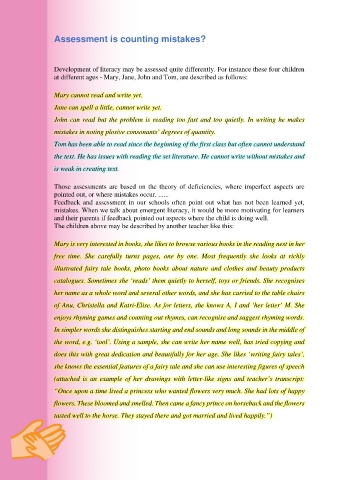Page 114 - Reading Nest - The Supportive Literacy Environment Handbook
P. 114
Assessment is counting mistakes?
Development of literacy may be assessed quite differently. For instance these four children
at different ages - Mary, Jane, John and Tom, are described as follows:
Mary cannot read and write yet.
Jane can spell a little, cannot write yet.
John can read but the problem is reading too fast and too quietly. In writing he makes
mistakes in noting plosive consonants’ degrees of quantity.
Tom has been able to read since the beginning of the first class but often cannot understand
the text. He has issues with reading the set literature. He cannot write without mistakes and
is weak in creating text.
Those assessments are based on the theory of deficiencies, where imperfect aspects are
pointed out, or where mistakes occur. ......
Feedback and assessment in our schools often point out what has not been learned yet,
mistakes. When we talk about emergent literacy, it would be more motivating for learners
and their parents if feedback pointed out aspects where the child is doing well.
The children above may be described by another teacher like this:
Mary is very interested in books, she likes to browse various books in the reading nest in her
free time. She carefully turns pages, one by one. Most frequently she looks at richly
illustrated fairy tale books, photo books about nature and clothes and beauty products
catalogues. Sometimes she ‘reads’ them quietly to herself, toys or friends. She recognises
her name as a whole word and several other words, and she has carried to the table chairs
of Anu, Christella and Katri-Elise. As for letters, she knows A, I and ‘her letter’ M. She
enjoys rhyming games and counting out rhymes, can recognise and suggest rhyming words.
In simpler words she distinguishes starting and end sounds and long sounds in the middle of
the word, e.g. ‘tool’. Using a sample, she can write her name well, has tried copying and
does this with great dedication and beautifully for her age. She likes ‘writing fairy tales’,
she knows the essential features of a fairy tale and she can use interesting figures of speech
(attached is an example of her drawings with letter-like signs and teacher’s transcript:
“Once upon a time lived a princess who wanted flowers very much. She had lots of happy
flowers. These bloomed and smelled. Then came a fancy prince on horseback and the flowers
tasted well to the horse. They stayed there and got married and lived happily.”)

